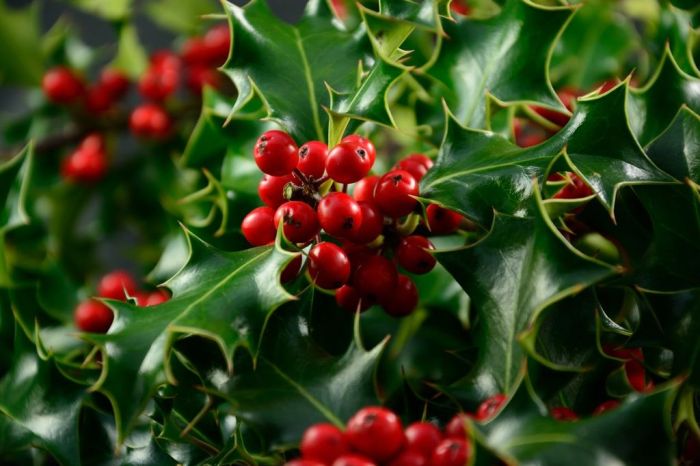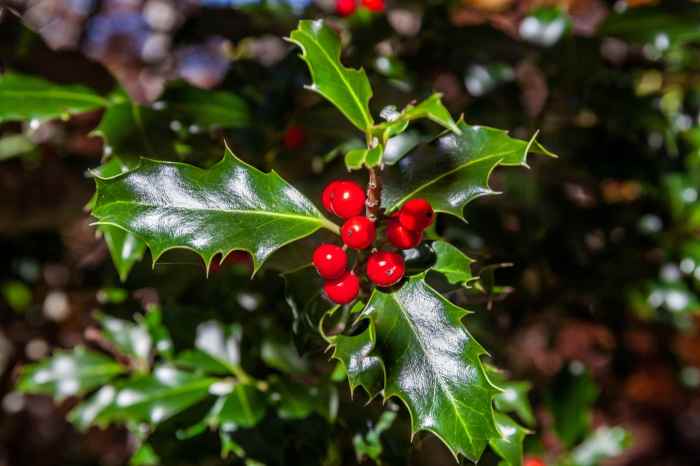Evergreen with red berries crossword – Embark on an intriguing journey into the captivating world of evergreen plants adorned with vibrant red berries. These botanical marvels, known for their enduring foliage and distinctive fruits, have captivated gardeners, naturalists, and crossword enthusiasts alike. Join us as we unravel the mysteries of evergreen plants with red berries, exploring their unique adaptations, ecological roles, cultural significance, and horticultural value.
From the towering majesty of coniferous trees to the graceful elegance of shrubs, evergreen plants with red berries exhibit a remarkable diversity. Their botanical characteristics, including adaptations that allow them to thrive in diverse environments, will be meticulously examined.
Botanical Characteristics: Evergreen With Red Berries Crossword

Evergreen plants with red berries are distinguished by their year-round foliage and the production of brightly colored berries. These plants have adapted to a wide range of environments, from temperate forests to coastal areas. Their botanical characteristics include:
- Evergreen foliage:Their leaves remain green throughout the year, allowing for continuous photosynthesis and year-round food production.
- Red berries:The berries are a defining feature of these plants, serving as a source of food for birds and other animals. The red color attracts birds, aiding in seed dispersal.
- Woody stems:These plants typically have woody stems that provide support and allow them to grow upright. The woody structure also enables them to withstand environmental stresses.
- Diverse growth forms:Evergreen plants with red berries can range from low-growing shrubs to tall trees, exhibiting a variety of growth habits.
- Adaptations for diverse environments:These plants have evolved specific adaptations to thrive in their respective habitats. For example, some species have thick, waxy leaves to reduce water loss in dry climates, while others have deep root systems to access water in arid regions.
Types and Varieties
There are numerous types of evergreen plants with red berries, each with unique characteristics. Some common species include:
- Ilex aquifolium(English Holly): A shrub or small tree with glossy, evergreen leaves and bright red berries. It is native to Europe and North Africa.
- Mahonia aquifolium(Oregon Grape): A shrub with compound leaves and blue-black berries. It is native to western North America.
- Arctostaphylos uva-ursi(Bearberry): A low-growing shrub with evergreen leaves and red berries. It is native to North America and Eurasia.
- Vaccinium vitis-idaea(Lingonberry): A low-growing shrub with evergreen leaves and bright red berries. It is native to northern Europe and North America.
- Taxus baccata(English Yew): A tree with evergreen leaves and fleshy, red berries. It is native to Europe, North Africa, and Asia.
Distribution and Habitat, Evergreen with red berries crossword
Evergreen plants with red berries are found in various parts of the world, including temperate forests, coastal areas, and mountainous regions. Their distribution is influenced by factors such as:
- Climate:These plants are typically found in regions with mild climates, where they can thrive without experiencing extreme cold or drought.
- Soil conditions:They prefer well-drained soils with adequate moisture and nutrients.
- Elevation:Some species are adapted to high altitudes, while others prefer lower elevations.
Examples of their distribution include:
- English Holly:Native to Europe and North Africa, it is commonly found in woodlands and hedgerows.
- Oregon Grape:Found in western North America, it prefers shady areas in forests and woodlands.
- Lingonberry:Native to northern Europe and North America, it grows in bogs, heaths, and coniferous forests.
- English Yew:Found in Europe, North Africa, and Asia, it is commonly found in ancient forests and churchyards.
Ecological Importance
Evergreen plants with red berries play significant ecological roles in various ecosystems:
- Food source:The berries provide a valuable food source for birds, mammals, and other animals. The bright color attracts birds, which aid in seed dispersal.
- Habitat:The dense foliage of these plants provides shelter and nesting sites for birds and other wildlife.
- Erosion control:Their extensive root systems help stabilize soil and prevent erosion.
- Nutrient cycling:The decomposition of their leaves and berries adds nutrients to the soil.
- Pollination:Some species produce flowers that attract pollinators, such as bees and butterflies.
Horticultural Significance
Evergreen plants with red berries are popular in landscaping due to their attractive appearance and year-round interest:
- Ornamental value:The combination of evergreen foliage and colorful berries provides a striking visual display.
- Winter interest:The berries persist throughout the winter, adding color and interest to gardens during the colder months.
- Versatile growth habits:The range of growth forms, from shrubs to trees, makes them suitable for various landscaping applications.
- Easy care:Many species are relatively low-maintenance and can thrive in a variety of conditions.
Cultural and Historical Uses
Evergreen plants with red berries have cultural and historical significance in many societies:
- Symbolism:In some cultures, the red berries represent fertility, love, and good fortune.
- Traditional medicine:Certain species have been used in traditional medicine for various ailments, including fever, headaches, and digestive issues.
- Folklore and mythology:These plants often appear in folklore and mythology, associated with fairies, elves, and other supernatural beings.
- Decorative purposes:The berries and foliage have been used in holiday decorations, such as Christmas wreaths and garlands.
Question & Answer Hub
What are the most common types of evergreen plants with red berries?
Examples include holly (Ilex spp.), pyracantha (Pyracantha spp.), and nandina (Nandina domestica).
Where are evergreen plants with red berries typically found?
They are widely distributed in temperate and subtropical regions around the world, often in forests, woodlands, and coastal areas.
What role do evergreen plants with red berries play in ecosystems?
They provide food and shelter for birds and other wildlife, and their dense foliage offers protection and nesting sites.

